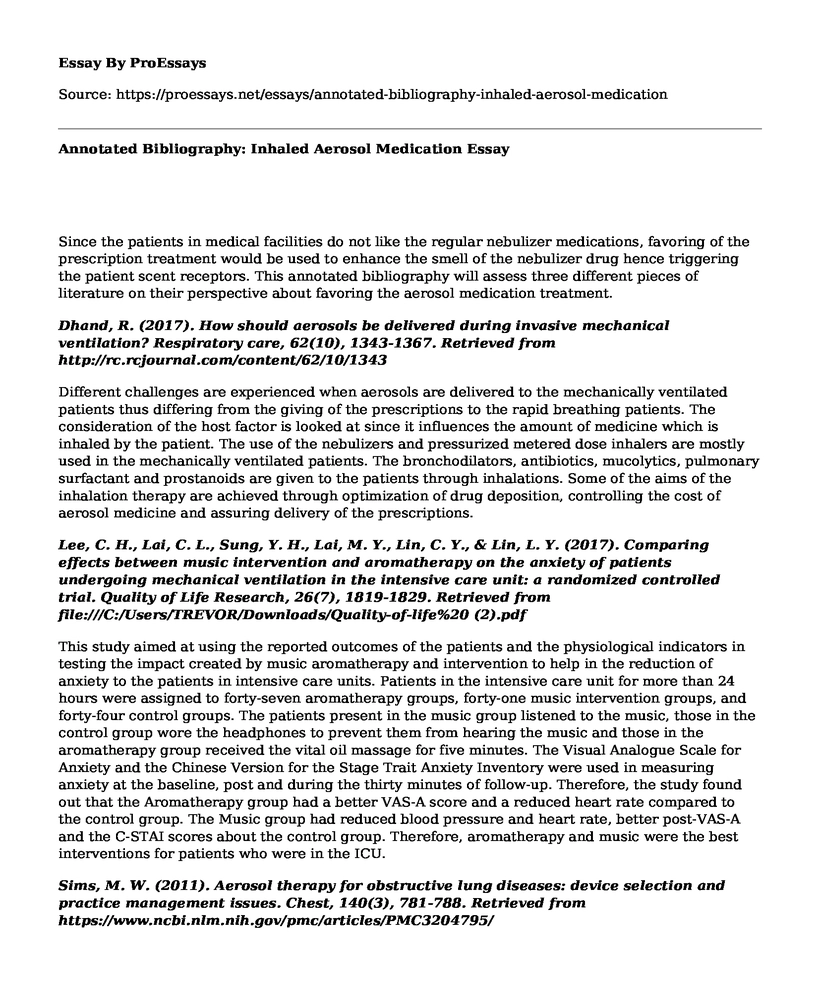Since the patients in medical facilities do not like the regular nebulizer medications, favoring of the prescription treatment would be used to enhance the smell of the nebulizer drug hence triggering the patient scent receptors. This annotated bibliography will assess three different pieces of literature on their perspective about favoring the aerosol medication treatment.
Dhand, R. (2017). How should aerosols be delivered during invasive mechanical ventilation? Respiratory care, 62(10), 1343-1367. Retrieved from http://rc.rcjournal.com/content/62/10/1343
Different challenges are experienced when aerosols are delivered to the mechanically ventilated patients thus differing from the giving of the prescriptions to the rapid breathing patients. The consideration of the host factor is looked at since it influences the amount of medicine which is inhaled by the patient. The use of the nebulizers and pressurized metered dose inhalers are mostly used in the mechanically ventilated patients. The bronchodilators, antibiotics, mucolytics, pulmonary surfactant and prostanoids are given to the patients through inhalations. Some of the aims of the inhalation therapy are achieved through optimization of drug deposition, controlling the cost of aerosol medicine and assuring delivery of the prescriptions.
Lee, C. H., Lai, C. L., Sung, Y. H., Lai, M. Y., Lin, C. Y., & Lin, L. Y. (2017). Comparing effects between music intervention and aromatherapy on the anxiety of patients undergoing mechanical ventilation in the intensive care unit: a randomized controlled trial. Quality of Life Research, 26(7), 1819-1829. Retrieved from file:///C:/Users/TREVOR/Downloads/Quality-of-life%20 (2).pdf
This study aimed at using the reported outcomes of the patients and the physiological indicators in testing the impact created by music aromatherapy and intervention to help in the reduction of anxiety to the patients in intensive care units. Patients in the intensive care unit for more than 24 hours were assigned to forty-seven aromatherapy groups, forty-one music intervention groups, and forty-four control groups. The patients present in the music group listened to the music, those in the control group wore the headphones to prevent them from hearing the music and those in the aromatherapy group received the vital oil massage for five minutes. The Visual Analogue Scale for Anxiety and the Chinese Version for the Stage Trait Anxiety Inventory were used in measuring anxiety at the baseline, post and during the thirty minutes of follow-up. Therefore, the study found out that the Aromatherapy group had a better VAS-A score and a reduced heart rate compared to the control group. The Music group had reduced blood pressure and heart rate, better post-VAS-A and the C-STAI scores about the control group. Therefore, aromatherapy and music were the best interventions for patients who were in the ICU.
Sims, M. W. (2011). Aerosol therapy for obstructive lung diseases: device selection and practice management issues. Chest, 140(3), 781-788. Retrieved from https://www.ncbi.nlm.nih.gov/pmc/articles/PMC3204795/
The inhaled aerosol medicines are the main treatments of the obstructive lung conditions. The aerosol devices are used to deliver prescriptions directly to the respiratory system hence allowing the concentration of the local drug which limits the systemic toxicity. It might seem confusing and arbitrary whenever the physician tries to choose the drug which suits a particular patient. The confusion brought about by the Current Procedural Terminology (CPT) coding for the administration of the aerosol therapies might cause loss of revenue from the wasted administrative efforts and under-billing of the rejected claims. Therefore, this article describes the aerosol tools which are available and discusses their advantages in a particular medical setting by summarizing the appropriate CPT coding which can be used in aerosol therapy.
References
Dhand, R. (2017). How should aerosols be delivered during invasive mechanical ventilation? Respiratory care, 62(10), 1343-1367. Retrieved from http://rc.rcjournal.com/content/62/10/1343
Lee, C. H., Lai, C. L., Sung, Y. H., Lai, M. Y., Lin, C. Y., & Lin, L. Y. (2017). Comparing effects between music intervention and aromatherapy on the anxiety of patients undergoing mechanical ventilation in the intensive care unit: a randomized controlled trial. Quality of Life Research, 26(7), 1819-1829. Retrieved from file:///C:/Users/TREVOR/Downloads/Quality-of-life%20 (2).pdf
Sims, M. W. (2011). Aerosol therapy for obstructive lung diseases: device selection and practice management issues. Chest, 140(3), 781-788. Retrieved from https://www.ncbi.nlm.nih.gov/pmc/articles/PMC3204795/
Cite this page
Annotated Bibliography: Inhaled Aerosol Medication. (2023, Jan 10). Retrieved from https://proessays.net/essays/annotated-bibliography-inhaled-aerosol-medication
If you are the original author of this essay and no longer wish to have it published on the ProEssays website, please click below to request its removal:
- Health Professional's Dilemmas Essay Example
- Questions and Answers Essay on Nursing and Drugs
- If Students With Disabilities Can be Educated in the General Education Classroom Essay
- Research Paper on AI in Pharma: Unlocking Scientific Breakthroughs Through Machine Learning
- Essay Sample on Digital Health Records: EMRs & EHRs - Improving Patient Care
- Paper Sample on Nurse Educators: Bridging the Gap Between Clinical Expertise and Educational Competence
- Free Report Example on Bergerac System







